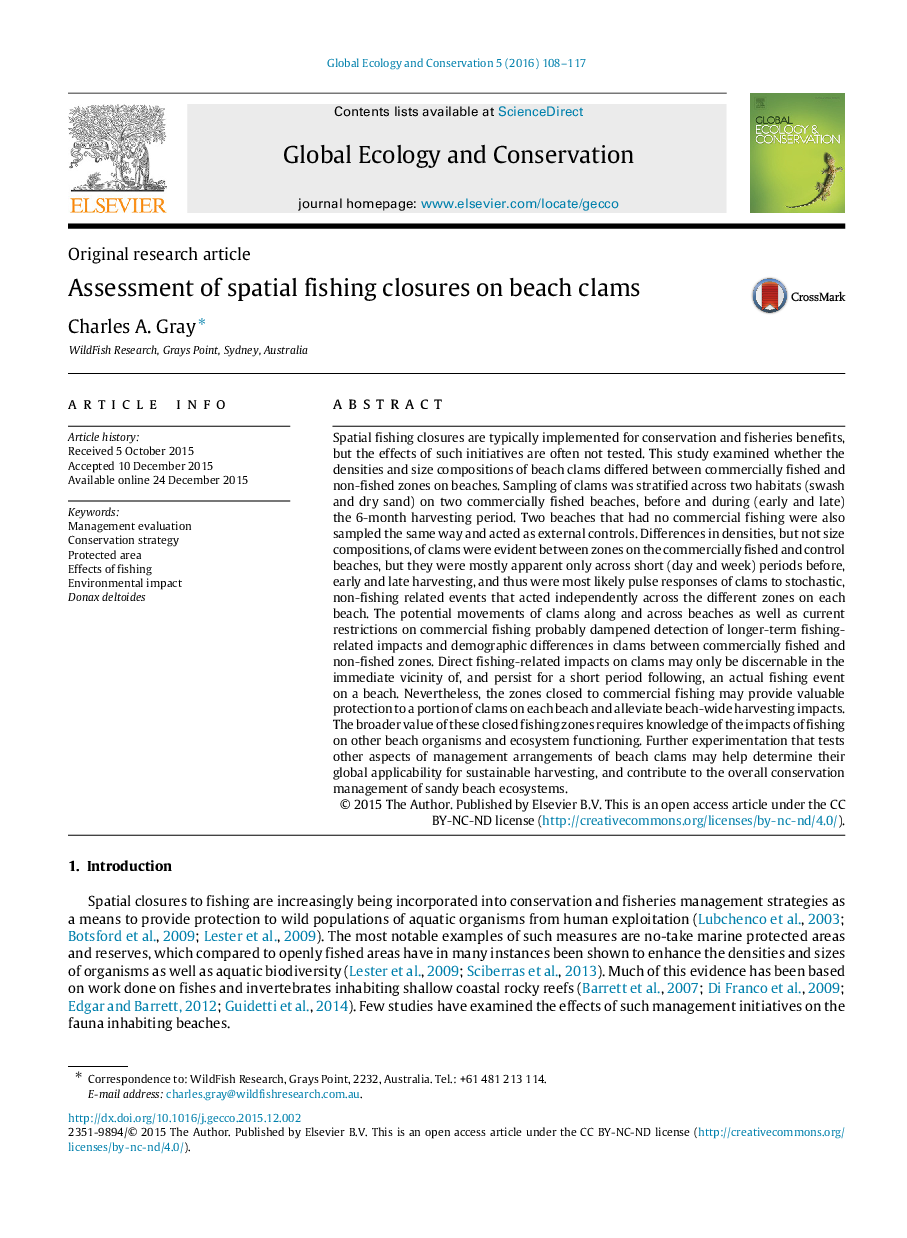| کد مقاله | کد نشریه | سال انتشار | مقاله انگلیسی | نسخه تمام متن |
|---|---|---|---|---|
| 4379713 | 1617662 | 2016 | 10 صفحه PDF | دانلود رایگان |
عنوان انگلیسی مقاله ISI
Assessment of spatial fishing closures on beach clams
ترجمه فارسی عنوان
ارزیابی بسته شدن ماهیگیری فضایی در ساحلی
دانلود مقاله + سفارش ترجمه
دانلود مقاله ISI انگلیسی
رایگان برای ایرانیان
کلمات کلیدی
ارزیابی مدیریت، استراتژی حفاظت، منطقه حفاظت شده، تأثیر ماهیگیری، اثرات زیست محیطی، دلتای دوناکس،
ترجمه چکیده
بستن ماهیگیری فضایی معمولا برای منافع حفاظت و شیلات اجرا می شود، اما تأثیر چنین ابتکاراتی اغلب تست نشده است. این مطالعه مورد بررسی قرار گرفت که آیا تراکم و اندازه ترکیبات ساحلی در بین سواحل در مناطق تجاری دریایی و غیر شکار تفاوت دارند. نمونه برداری از کوهنوردی در دو زیستگاه (سقوط و خشک شن و ماسه) بر روی دو سواحل تجاری فیشر قبل و در اواسط و در پایان دوره ی برداشت 6 ماهه طبقه بندی شد. دو سواحل که هیچ ماهیگیری تجاری نداشتند نیز به همان شیوه نمونه برداری شده و به عنوان کنترل های خارجی عمل می کردند. تفاوت بین تراکم ها، اما اندازه های کمپوست، از بین مناطق در سواحل تجاری تجاری و کنترل شده مشهود بود، اما بیشتر آنها تنها در دوره کوتاه (روز و هفته) قبل، زودرس و در اواخر برداشت، و به این ترتیب، به احتمال زیاد نبض بودند پاسخ های کلاه به رویدادهای تصادفی، غیر ماهیگیری که به طور مستقل در مناطق مختلف در هر ساحل عمل می کردند. جنبش های بالقوه سیب زمینی در امتداد و در سراسر سواحل و همچنین محدودیت های فعلی در ماهیگیری تجاری احتمالا باعث شناسایی اثرات مرتبط با ماهیگیری طولانی مدت و تفاوت های جمعیت شناختی در ماهی های دریایی بین مناطق تجارتی و غیر شکار می شود. تأثیرات مستقیم ماهیگیری در قارچ ها ممکن است در محدوده ی مجاور قابل تشخیص باشد و برای مدت کوتاهی پس از یک رویداد ماهیگیری واقعی در ساحل ادامه یابد. با این وجود، مناطق بسته به ماهیگیری تجاری ممکن است حفاظت ارزشمندی را برای بخشی از ماهیها در هر ساحل و کاهش اثرات برداشت ساحلی به همراه داشته باشند. ارزش گسترده ای از این مناطق ماهیگیری بسته به آگاهی از تاثیرات ماهیگیری در دیگر موجودات ساحل و عملکرد اکوسیستم نیاز دارد. آزمایش های بیشتری که جنبه های دیگر تدارکات مدیریت ریزش های ساحلی را تست می کنند ممکن است به تعیین کاربرد جهانی آن برای برداشت پایدار کمک کند و به مدیریت کلی حفاظت از اکوسیستم های ساحل شنی کمک نماید.
موضوعات مرتبط
علوم زیستی و بیوفناوری
علوم کشاورزی و بیولوژیک
بوم شناسی، تکامل، رفتار و سامانه شناسی
چکیده انگلیسی
Spatial fishing closures are typically implemented for conservation and fisheries benefits, but the effects of such initiatives are often not tested. This study examined whether the densities and size compositions of beach clams differed between commercially fished and non-fished zones on beaches. Sampling of clams was stratified across two habitats (swash and dry sand) on two commercially fished beaches, before and during (early and late) the 6-month harvesting period. Two beaches that had no commercial fishing were also sampled the same way and acted as external controls. Differences in densities, but not size compositions, of clams were evident between zones on the commercially fished and control beaches, but they were mostly apparent only across short (day and week) periods before, early and late harvesting, and thus were most likely pulse responses of clams to stochastic, non-fishing related events that acted independently across the different zones on each beach. The potential movements of clams along and across beaches as well as current restrictions on commercial fishing probably dampened detection of longer-term fishing-related impacts and demographic differences in clams between commercially fished and non-fished zones. Direct fishing-related impacts on clams may only be discernable in the immediate vicinity of, and persist for a short period following, an actual fishing event on a beach. Nevertheless, the zones closed to commercial fishing may provide valuable protection to a portion of clams on each beach and alleviate beach-wide harvesting impacts. The broader value of these closed fishing zones requires knowledge of the impacts of fishing on other beach organisms and ecosystem functioning. Further experimentation that tests other aspects of management arrangements of beach clams may help determine their global applicability for sustainable harvesting, and contribute to the overall conservation management of sandy beach ecosystems.
ناشر
Database: Elsevier - ScienceDirect (ساینس دایرکت)
Journal: Global Ecology and Conservation - Volume 5, January 2016, Pages 108-117
Journal: Global Ecology and Conservation - Volume 5, January 2016, Pages 108-117
نویسندگان
Charles A. Gray,
